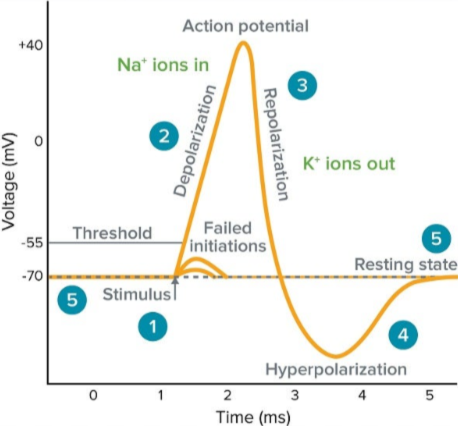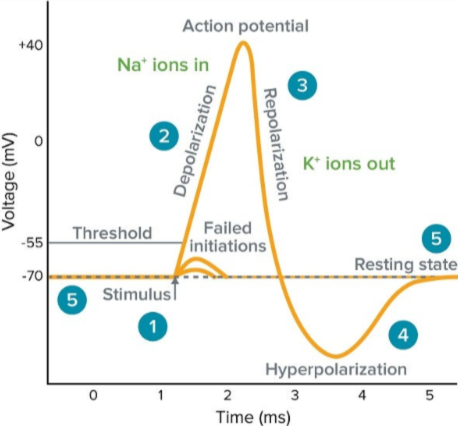Chapter 27 AP Bio neurons, synapses, signaling
1/43
Earn XP
Description and Tags
going through AP Bio packet in order
Name | Mastery | Learn | Test | Matching | Spaced |
|---|
No study sessions yet.
44 Terms
Neurons
nerve cells that transfer info within the body
How do neurons communicate?
Neurons use 2 types of signals to communicate:
-Electrical signals (long distance)
-Chemical signals (short distance)
Ganglia
simple clusters of neurons where processing of info takes place
Brain
a more complex organization of neurons
Cell body
where most of a neuron’s organelles are
Dendrites
Most neurons have these highly branched extensions that receive signals from other neurons
Axon
the single axon, a MUCH LONGER extension, transmits signals to other cells
Axon hillock
the cone-shaped base of an axon, where signals are generated
Synapse
the branched ends of axons that transmit signals to other cells at a junction
Glial cells
neurons of vertebrates
Neurotransmitters (NT’s)
at most synapses, NT’s are chemical messengers that pass info from the transmitting neuron to receiving cell
Astroglia
provide physical and nutritional support for neurons
Microglia
digest parts of dead neurons
Oligodendrioglia
provide the insulation (myelin) to neurons in the CNS
Satellite cells
physical support of neurons in the PNS
Schwann cells
provide the insulation (myelin to neurons in the PNS)
Sensory neurons
transmit info from eyes and other sensors that detect external stimuli or internal conditions
Interneurons
sensory neural info is sent to the brain/ ganglia, where interneurons integrate the info
Motor neurons
neurons that extend out of the processing centers trigger muscle/ gland activity, for ex. motor neurons transmit signals to muscle cells, causing them to contract
Central Nervous System (CNS)
in many animals, neurons that carry out integration are organized in the CNS
Peripheral Nervous System (PNS)
the neurons that carry info INTO & OUT of the CNS
Nerves
are PNS neurons bundled together
The inside of a cell is _____ charged relative to the outside
What is this difference called?
(—) NEGATIVELY charged
this difference is a source of potential energy called membrane potential
RESTING potential
is the membrane potential of a neuron NOT sending signals
-changes in membrane potential act as signals, transmitting and processing info
Sodium-potassium pumps
K+ & Na+ play an essential role in forming the resting potential, in most neurons, the conc. of K+is highest INSIDE cell, while conc. of Na+ is highest cell
-THESE pumps use the energy of ATP to maintain these K+ & Na+ gradients across the plasma membrane
Ion channels
the opening of ion channels in the plasma membrane converts the Chemical P.E of the ion gradients to Electrical P.E
-ion channels are selectively permeable, allowing ONLY certain ions to pass thru
-a resting neuron has MANY OPEN K+ channels, (leaky channels) allowing Na+ to flow OUT
-the resulting buildup of negative (—) charge within the neuron is the major source of membrane potential
-in a resting neuron, the currents of K+ & Na+ are = & opposite, and the resting potential across the membrane remains steady
Hyperpolarization
-this is when gated K+ channels open, K+ diffuses out, making the inside of cell more (—) negative, this is hyperpolarization, an INCREASE in magnitude of membrane potential
Depolarization
notes: opening other types of ion channels triggers a depolarization, a reduction in the magnitude of the membrane potentials
simple terms: “when a cell’s electrical charge becomes less (—)negative, or more (+), compared to its surroundings, so losing its polarized state, which is crucial for cell communication and function:
Graded potentials
are changes in polarization where the magnitude of the change varies with the strength of the stimulus
or “localized, short-lived changes in a cell’s membrane potential that vary in strength based on a stimulus
Action potentials
simple: a rapid, temporary shift in the electrical charge across a cell membrane, like a nerve cell, that signals the cell as “active”and allows it to transmit signals
notes: if a depolarization shifts the membrane potential sufficiently, it results in a massive change in membrane voltage, called an action potential
-Action potentials have a constant magnitude and transmit signals over long distances
Voltage gated ion channels
action potentials arise because some ion channels are voltage gated, opening/ closing when the membrane potential passes a certain level
Threshold
the critical level of membrane depolarization (a change in electrical charge inside a cell) that a neuron must reach to trigger an action potential, a rapid electrical signal that allows neurons to communicate.

Stages for an Action Potential
At resting potential
Most voltage-gated sodium (Na+) & potassium (K+) channels are closed
When stimulus depolarizes the membrane
Some gated Na+ channels open 1st, and Na+ flows into the cell
During the Rising phase, the threshold is crossed, & the membrane potential increases
During the Falling phase, voltage-gated Na+ channels become Inactivated; voltage-gated K+ channels open, & K+ flows out of the cell
During the Undershoot, membrane permeability to K+ is at 1st higher than at rest, but then voltage-gated K+ channels close & resting potential is restored

Refractory period
during the refractory period, after an action potential, a 2nd action potential CAN’T be initiated
-this period is a result of a temporary Inactivation of Na+ channels
-for most neurons, the interval btwn the start of an action potential and the end of the refractory period is only 1-2 msec
Conduction of Action potentials
-at the site where the action potential is initiated (usually the axon hillock), an electrical current depolarizes the neighboring region of the axon membrane
-action potentials travel ONLY toward the synaptic terminals
-Inactivated Na+ channels behind the zone of depolarization prevent the action potential from traveling backward
Most synapses are chemical synapses, in which a chemical neurotransmitter carries info from the ___ neuron to the ____ cell
presynaptic neuron to the postsynaptic cell
The arrival of the action potential causes the ______ of the neurotransmitter
release
The neurotransmitter diffuses across the ____ ____ & is received by the ______ cell
synaptic cleft & is received by the postsynaptic cell
Ligand-gated ion channels in the postsynaptic cell
Direct synaptic transmission involves binding of neortransmitters to ligand-gated ion channels in the postsynaptic cell
-neurotransmitter binding causes ion channels to open, generating a postsynaptic potential, postsynaptic potentials fall into 2 categories, EPSPs & IPSPs
Excitatory Postsynaptic Potentials (EPSPs)
from notes: are depolarizations that bring the membrane potential toward threshold
simple terms: a temporary change in the electrical charge of a neuron's membrane that makes it more likely to fire an action potential, caused by the influx of (+) charged ions
-a single EPSP is usually TOO SMALL to trigger an action potential in a postsynaptic neuron
Inhibitory Postsynaptic Potentials (IPSPs)
“think inhibit, stop, brake”
from notes: are hyperpolarizations that move the membrane potential farther from threshold
simple terms: a signal that makes a neuron less likely to fire an action potential, effectively acting as a "brake" on neural activity
The cell body of 1 postsynaptic neuron may receive inputs from _______ of synaptic terminals
hundreds of thousands
Temporal & Spatial Summation
-If 2 EPSP’s are produced in rapid succession, an effect called occurs
-In Spatial Summation, EPSPs produced nearly simultaneously by different synapses on the same postsynaptic neuron ADD together
-the combination of EPSPs thru spatial & temporal summation can trigger an Action Potential
-Thru summation, an IPSP can counter the effect of an EPSP
-the summed effect of EPSPs and IPSPs determines whether an axon hillock will reach threshold and generate an action potential
Acetylcoline (ACH) “MML” -muscle, memory, learning
-a common neurotransmitter in both invertebrates & vertebrates
-ACH is VITAL for functions involving MUSCLE stimulation, Memory formation, & learning
-a single nt may have more than a dozen different receptors
-signaling at the synapse brings about a response that depends on both the neurotransmitter from the presynaptic cell and the receptor on the postsynaptic cell